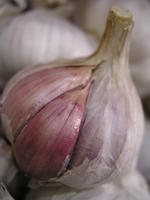
Plant Description
The plant has roots that protrude from the base of the bulb that are made up of between 6 and 12 cloves. The stem is relatively short, about six centimetres long, and extends to just above the ground.
From there the flat grass-like leaves extend about 15 to 20 cm above ground. The leaves are similar to but are slightly different from onion and leeks in that they are flatter whereas the other Alliums have more rounded leaves.
Uses
Garlic has been used for medicinal purposes as an anti-inflammatory, it is also believed to lower blood pressure and control cholesterol levels and has been used as a condiment for over 5000 years.Soil Requirements and Preparation
The best soils are sandy loam soils with good drainage and with a pH of 6 to 7. Soils should be rich in organic matter. If required mix manure or compost in well before planting when preparing and levelling the area for planting. The ground should be ploughed to a depth of about 20 cm deep. This preparation also controls the weeds in the topsoil.Climate
Garlic can be grown in a wide climate range. The best temperature range during its growing season is between 12 and 28 degrees centigrade. It can withstand colder weather and warmer conditions but this reduces growth and bulb development.
It is sensitive to moisture stress because of its shallow root system. It is therefore advisable to plant under controlled irrigation and not rely on rainfall if consistent higher yields are desired.
Cultivars
There are two types of garlic. Soft neck garlic and hard neck garlic, and each type has many selections or varieties. The most popular type grown in South Africa is the soft neck types because they are hardier, and they can be stored for longer periods.
The soft neck garlic has more cloves than hard neck garlic which tends to have less, bigger cloves. What also protects the cloves of the soft neck garlic is that it has more outer papery skin layers surrounding the cloves which make up the ball.
Hard neck garlic has fewer and very thin outer skin layers and does not store well. Soft neck garlic varieties: Silverskin and Artichoke Hard neck garlic varieties: Rocambole, Porcelain and Purple Stripe
By Louise Brodie